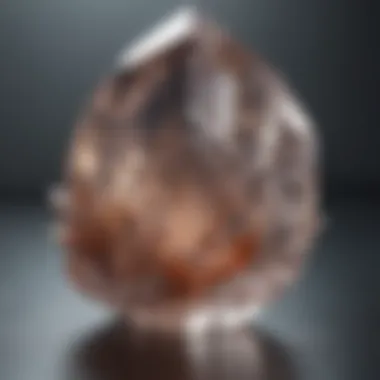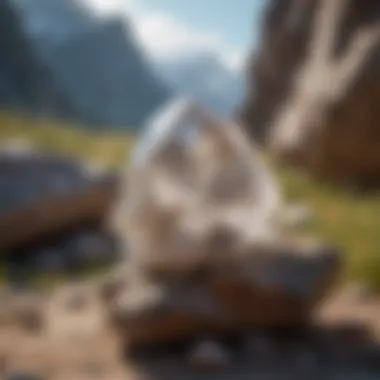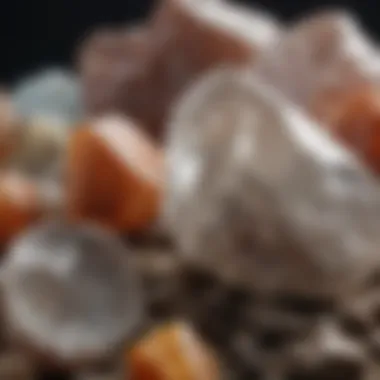Identifying Quartz: A Comprehensive Guide to Recognition


Intro
Identifying quartz can be both interesting and rewarding for collectors. Understanding its characteristics helps distinguish it from other minerals.
Rock and Fossil Identification
Types of Rocks and Fossils
Quartz is commonly found in igneous, sedimentary, and metamorphic rocks. Its presence often influences the overall composition and appearance of the rock. Knowing the types of rocks is beneficial in identifying quartz. Geological formations that are rich in quartz include granite and sandstone.
Characteristics to Look For
Important signs of quartz include its hardness, glossy surface, and its ability to form hexagonal crystals. Quartz typically ranges from clear to various colors including pink, purple, and smoky hues. Pay attention to the transparency, which is often a significant clue.
Tools for Identification
A few tools can assist in identifying quartz. A jeweler's loupe helps in inspecting crystal formations. A hardness test kit, or simply using a glass plate, can help determine quartz's hardness, rated at 7 on the Mohs scale.
Collecting Tips and Techniques
Best Practices for Collecting
Collect responsibly to preserve the ecosystem. Only take what you need and respect local rules.
Locating Prime Collecting Sites
Search areas near rivers or mountains. These locations may reveal quartz-rich deposits. Combining geological maps with local knowledge can enhance your search.
How to Safely Extract Specimens
Use simple tools like hammers or chisels but ensure safety gear like gloves and goggles are utilized during collection.
Preservation and Display
Techniques for Preserving Rocks and Fossils
Keep your specimens dry and avoid exposure to harsh sunlight. Use preservation wax or resins for more delicate items.
Proper Storage Methods
Store specimens in containers that minimize movement. Acid-free packaging materials and display cases work well.
Creative Display Ideas
Use simple yet elegant shelves for organized views. Labels can enhance educational value, providing context about each specimen.
Geological Insights
Geological Formations and Processes
Understanding geological processes helps contextualize where quartz originates. It plays a fundamental role in the Earth's crust, often formed from volcanic activity.
Historical Significance of Rocks and Fossils
Rocks carry significant historical stories about the Earth's past. Their study sheds light on the environmental changes over millions of years.
Notable Discoveries in the Field
Throughout history, quartz has been essential in technological advances. Notable deposits in regions such as Brazil and Arkansas have led to vital industrial uses.
Quartz's various applications in technology and industry highlight its importance beyond geology alone.
For more on this topic, you can visit /en.wikipedia.org, or you may find user discussions on resources like /reddit.com.
Foreword to Quartz


The study of quartz is notable for both its scientific foundation and implications for collecting practices. Understanding quartz is vital for rock enthusiasts as it serves as a cornerstone in identification techniques and geological studies. Quartz abundantly appears in various geological environments, making its identification crucial for collectors who strive to expand their knowledge base in mineralogy.
Definition and Origins
Quartz, a mineral composed primarily of silicon dioxide, has a well-defined crystalline structure. It occurs in several forms, each distinguished by unique physical properties. Often found in igneous, metamorphic, and sedimentary rocks, quartz is one of the most abundant minerals in the Earth's crust. Its origins trace back to several geological processes, particularly the cooling and solidification of magma or the metamorphism of existing rocks. This mingling of history determines the distinct appearance of quartz.
Importance in Geology and Collecting
Quartz serves various purposes that go beyond mere identification. Its presence indicates specific geological conditions and contributes to understanding Earth's physical history. For instance, the formation of certain types of quartz can suggest past volcanic activity or sediment processes.
For collectors seeking to distinguish genuine quartz from imitations, recognizing the mineral's characteristic traits is essential. While it may be visually appealing and commonly collected, quartz serves as a benchmark by which other minerals can be evaluated.
The insigths gleaned from identifying quartz empower collectors not only with refined skills but also enrich their appreciation of geology as a whole. Thus, gathering knowledge about quartz is more than an exercise in recognition; it provides meaningful context for every piece collected, deepening the overall experience in the field.
Physical Properties of Quartz
Understanding the physical properties of quartz is critical for both novice rock collectors and seasoned geologists alike. Recognizing quartz among other minerals often relies on these characteristics. Being aware of quartz's unique attributes allows collectors to efficiently narrow down a material's identity in the vast array of rocks.
Color Variations
Quartz exhibits a remarkable variety of colors due to the presence of impurities and varying conditions of formation. The color can affect not only the aesthetic appeal but also the classification of quartz types, such as amethyst or citrine.
Some common color variations include:
- Clear Quartz: Typically colorless, it is often seen as pure quartz.
- Amethyst: Exhibits a violet hue caused by iron impurities and natural radiation.
- Citrine: Shows yellow to brown colors, resulting from iron exposure.
- Smoky Quartz: Takes on a brown or black appearance as a result of natural radiation.
These múltiples colors appeal to collectors, providing diversity in collections and greater understanding of quartz’s geological context.
Crystal Structure
Quartz has a distinct hexagonal crystal structure owing to its molecular composition, which consists of silicon and oxygen atoms arranged in a specific repeating pattern. This structural integrity promotes the characteristic crystal form associated with quartz.
Recognizing the typical form can be helpful in identification:
- Hexagonal Crystals: Quartz generally forms hexagonal prism shapes.
- Double Termination: Some crystals have points on both ends—an interesting feature among collectors.
An observer should also notice the transparency and clarity levels which can highlight whether it is high-quality quartz or more opaque variants.
Hardness and Luster
Quartz ranks a 7 on the Mohs scale, denoting its durability compared to many other minerals. This hardness is advantageous for collectors; quartz artifacts may survive significant abuse without damage.
In terms of luster, quartz typically reflects light well, displaying a glassy finish. The brilliance can differ among varieties, thus observing the luster is key for identification.
- Glassy Luster: Generally clear quartz results in a more reflective appearance.
- Resinous Luster: Others with a slightly darker color may exhibit a quality that appears waxy or resinous.
Common Forms of Quartz
Identifying quartz often includes recognizing its various forms. Understanding these forms is vital for collectors and geology enthusiasts alike. Each type displays distinct characteristics that aid in identification. This knowledge enhances appreciation for the diversity found in quartz and helps avoid confusion with other minerals.
Geodes and Druse
Geodes are spherical formations with a hollow center, often lined with crystals. They can fluctuate in size butÑ usually bigger than a marble. When broken open, they present layers of quartz that create an impressive interior. Druse refers to a surface covered in tiny, sparkling quartz crystals. These sparkling surfaces can be both beautiful and useful in identifying quartz.
/Characteristics of Geodes and Druse:
- Appearance: Typically round and rocky.
- Interior: Can display a variety of crystal types, most prominently quartz.
- Common Locations: Often found in volcanic or sedimentary rocks.
Recognizing geodes especially requires careful inspection. When identifying larger geodes, weight can sometimes give additional clues. Lighter specimens may indicate they are hollow.
Citrine and Amethyst
Citrine and amethyst are two popular varieties of quartz. They both showcase distinctive colors due to impurities and treatments. Citrine generally exhibits a yellow to brownish tint, while amethyst shows varying shades of purple.
/Characteristics of Citrine and Amethyst:


- Citrine:
- Amethyst:
- Color: Yellow to brown.
- Origin: Natural or heat-treated amethyst.
- Color: Purple shades ranging from light to dark.
- Popular use: Many desire amethyst for jewelry and decoration.
Minerals enthusiasts should be aware that heat and light will affect the coloring in these types of quartz. Adjusting their environment or exposure can potentially alter the appearance of these quartz variations.
Clear Quartz and Smoky Quartz
Clear quartz is one of the most common forms of quartz, distinguishable for its transparent appearance. On the other hand, smoky quartz displays a brown to black hue that contributes to its unique characterization.
/Characteristics of Clear Quartz and Smoky Quartz:
- Clear Quartz:
- Smoky Quartz:
- Appearance: Often reflects sunlight.
- Uses: Used in healing, electronics, and aesthetics.
- Appearance: Can range from translucent gray to nearly opaque.
- Significance: Considered protective and grounding by many.
Both these forms bear significance to rock collectors. Clear quartz is prevalent and easily found. Smoky quartz requires more discernment due to its coloration, making each specimen an opportunity for interesting comparisons in identification skills.
Identifying Quartz in the Field
Identifying quartz in the field is a crucial step for any rock and fossil collector. Differentiating quartz from other minerals allows collectors to build more informative collections and enhance their understanding of mineralogy. This process goes beyond visual examination; it includes multiple senses and practical tests that can confirm your findings. Accurate identification decreases the chance of making mistakes and increases enjoyment in your collecting experience.
Visual Inspection Checklist
Before diving into the field tests, it is wise to have a clear visual checklist to help in identifying quartz easily. Key aspects to observe include:
- Color: While quartz can be clear, it also comes in various colors such as pink, purple, or brown.
- Transparency: Quartz crystals can often allow light to pass through.
- Crystal Shape: Natural quartz often displays hexagonal crystals.
- Luster: It usually has a vitreous (glass-like) appearance.
- Cleavage or Fracture: Quartz is known to fracture irregularly without distinct cleavage planes.
Reviewing these characteristics beforehand streamlines the identification process.
Using Touch and Feel
Touch can be a beneficial way to discern the properties of quartz. When handling a rock suspected to be quartz:
- Surface Texture: Quartz feels typically smooth to the touch. This can help confirm its identity alongside other characteristics.
- Weight: Generally, quartz feels denser compared to some similar minerals.
- Thermal Conductivity: Some rocks might feel warmer than others; however, this is a subtle detail.
Being mindful of these tactile elements can effectively aid in confirming your initial observations.
Conducting Simple Tests
Hardness Test
The hardness test is a reliable method to establish whether the sample is quartz. The key characteristic of quartz is its hardness; it scores a level of 7 on the Mohs hardness scale. This makes quartz harder than many common minerals. To perform this test you could:
- Use a mineral of known hardness for comparison, e.g., a steel nail.
- Scratch the surface of your specimen gently. If it leaves a mark, it is softer than quartz.
This test is beneficial because it can quickly rule out softer minerals which wouldn’t hold up under quartz’s hardness. However, careful handling is necessary to avoid damaging sensitive samples. The uniqueness of the hardness test lies in its accessibility, using common objects for assessment.
Acid Test
The acid test is another effective means for distinguishing quartz, particularly when concerned with potential misleading substances. The essential aspect of the acid test for quartz is its inertness to weak acid solutions, such as vinegar. To conduct this test:
- Apply a few drops of acetic acid or hydrochloric acid to your sample.
- Observe any reaction; quartz should not react or fizz as calcite would.
This characteristic makes the acid test a favorable option for novice and experienced collectors alike. Not reacting implies that your sample is most likely quartz. Like the hardness test, this method is simple and does not require complex techniques. Yet, care must be taken, as not all rocks are suitable for acid testing.
In summary, utilizing these visual checklists, tactile insights, and simple tests will enhance your ability to accurately identify quartz. Each step draws on different senses to provide a holistic view for the collector.
Common Mistakes in Identification
Identifying quartz among other minerals can be tricky. Many enthusiasts make mistakes during this process. A solid comprehension of how to accurately recognize quartz is key. Misidentifying another mineral as quartz can lead to misinformation and a loss of potential valuable samples. Recognizing these common errors helps collectors and geologists refine their skills.


Misidentifying Other Minerals
Flint
Flint is often confused with quartz due to its similar appearance. However, there are notable differences. Flint is actually a type of chert and tends to be more opaque. Its often darker colors can make it appear less shiny than typical quartz. A key aspect of flint is its conchoidal fracture, which bears signature curves characterized by shell-like patterns.
This particular feature, along with its granular texture, sets it apart from quartz. Former indective and beginners may overlook these distinctions, causing flint rock misclassification. Nonetheless, understanding this difference is valuable for identification. Flint, recognized for its ecclesiast root usages in tools, creates a unique focus on history in studying mineral collections.
Glass
Glass presents another challenge in identifying quartz. Much like quartz, glass can be shiny and glassy, causing overlap in basal observation. A particular characteristic of glass is the manner it can fracture; it typically demonstrates angular breaks while quartz shows much smoother surfaces.
The transparency of glass can mimic clear quartz directly. For collectors and some amateurs, this can become problematic. Thus, the density of the sample provides helpful clues. Glass has a lower density than quartz. Proper observation can illustrate why mishandling these differences causes frequent replicable mistakes in identification.
Overlooking Key Characteristics
Common errors may also arrise from those still depthging into rock collections and misjudging important moot maintenance factors. Identifiers might disregard quartz's typical cryptocracy form as seen in pointed crystal tips. The presence of mainsarten and transparent quality often confirms upcoming clarity and loyalty of the specimen.
Identifcating high-quality specimens demands an observative effort even in the most minute details. Calatines like opaque, broken and patinia envlytics may deceptively impair perception selecting idealing forms affecting immersion undertaken.
By becoming aware of these mistakes and their nuances, collectors enhance their understanding of this field. Identifying these characteristics between minerals nurtures well-informed dialogue for future explorations.
Resources for Collectors
Understanding quartz is only part of the journey for rock and fossil collectors. Post-identification, the availability of robust resources amplifies the journey of learning. Resources are crucial for developing a deeper appreciation of quartz and related minerals. It enhances knowledge, encourages exploration, and fosters community engagement.
Books and Field Guides
Books and field guides are invaluable for both novice and experienced collectors. They offer critical information classified in a structured manner. This helps in understanding different quartz varieties and their geological context. Titles like "Smithsonian Handbooks: Rocks and Minerals" or "National Audubon Society Field Guide to North American Rocks and Minerals" provide extensive insights into the characteristics and formations of quartz. Furthermore, visuals in these guides aid in recognizing physical traits of various quartz forms.
- Detailed descriptions assist in direct comparison and verify identifications.
- Most of these resources include diagrams, photos, and practical tips.
- Targeted sections on quartz improve retrieval of much-needed information when in the field.
Overall, these books strengthen one’s expertise. They act as a sturdy base for continued education about minerals in general.
Online Communities and Forums
In the digital age, online communities and forums serve a significant role in resource accessibility. Platforms such as Reddit and various Facebook groups host a diverse community of collectors. Engaging with these communities opens channels for exchanging valuable experiences.
- Collectors can ask specific questions and yield prompt feedback from more seasoned members.
- Shared photos spark discussions on common misidentifications and best practices.
- Many forums keep tabs on current trends in collecting and reward valuable contributions from members.
With this interconnectedness, it becomes easier to form collaborations for hunting quartz in various locales. The digital arena complements hands-on experience by refining one’s skills.
Workshops and Courses
Workshops and courses present a formal channel dedicated to quartz and mineral identification. Many institutions offer compact courses powered by professionals engrossed in geology. Attendees gain insights through lectures, personal guidance, and practice sessions.
Benefits of such courses include:
- Practical experience with real samples, equipping participants with firsthand knowledge.
- Interaction with experts allows for tailored guidance on identifying challenges.
- Networking opportunities thrive at these events, increasing spatial resourcefulness among collectors.
Most importantly, these workshops adapt to the varying levels of prior knowledge. Therefore, no one feels overwhelmed while also benefiting from shared experiences in quartz identification.
As the realm of geology and rock collecting evolves, strong resources foster a culture of ongoing learning and community engagement surrounding quartz.
Epilogue
The role of concluding this article is essential for synthesizing the information imparted throughout. A well-organized conclusion compiles the vital insights presented, allowing readers to retain and reinforce their understanding. This section does not merely repeat points already made but emphasizes the importance of the themes discussed.
Recap of Key Points
In summary, identifying quartz involves a close examination of its unique characteristics. Readers explore the definitions, forms, properties, and phenomena that set quartz apart from other minerals. Key components highlighted in this article include:
- Physical Properties: The specific color variations, distinct crystal structure, and hardness that differentiate quartz.
- Common Forms: Insights into various types such as geodes, citrine, and smoky quartz, expanding knowledge on what quartz can look like.
- Identification Techniques: Methods ranging from visual checks to tactile assessments, backed by simple yet effective tests that can ascertain a rock's identity.
These elemental discussions not only lay the groundwork in quartz classification but also enhance the skills necessary for any aspiring ethical collector.
Encouragement for Further Exploration
As this article strives to provide an indispensable tool for rock identification, the journey for collectors should not stop here. Incorporating the guidance from this resource into fieldwork will foster deeper insights into the world of geology. It assists in refining observational skills and encourages sharing experiences within communities that hold diverse knowledge. Many resources such as Books and Field Guides, Online Communities, or even workshops can offer further education and practical application.
Embarking on this journey ignites the opportunity to discover different minerals, appreciate Earth's geology, and engage with fellow collectors who share the same enthusiasm for exploration. Continued advancements in identification techniques and honing one's observational prowess remain crucial in this ever-evolving field.







